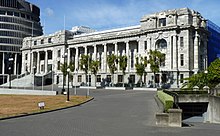| 46th Parliament of New Zealand | |||||
|---|---|---|---|---|---|
| |||||
 | |||||
| Overview | |||||
| Legislative body | New Zealand Parliament | ||||
| Term | 20 December 1999 – 11 June 2002 | ||||
| Election | 1999 New Zealand general election | ||||
| Government | Fifth Labour Government | ||||
| House of Representatives | |||||
 | |||||
| Members | 120 | ||||
| Speaker of the House | Jonathan Hunt | ||||
| Leader of the House | Michael Cullen | ||||
| Prime Minister | Helen Clark | ||||
| Leader of the Opposition | Bill English — Jenny Shipley until 8 October 2001 | ||||
| Sovereign | |||||
| Monarch | Elizabeth II | ||||
| Governor-General | Silvia Cartwright from 4 April 2001 — Michael Hardie Boys until 21 March 2001 | ||||
The 46th New Zealand Parliament was a term of the New Zealand Parliament. Its composition was determined by the 1999 election, and it sat until the 2002 election.
The 46th Parliament marked a change of government, with a coalition of the Labour Party and the Alliance taking office. Helen Clark replaced Jenny Shipley as Prime Minister. The National Party, which had formed a minority government for the last part of the 45th Parliament, became the largest opposition party, eventually emerging under a new leader, Bill English. Other parties in Parliament were ACT, the Greens, New Zealand First, and United. Several parties represented at the end of the previous Parliament, such as Mauri Pacific, were wiped out, failing to retain any of their seats.
The 46th Parliament consisted of one hundred and twenty representatives. Sixty-seven of these representatives were chosen by geographical electorates, including six Māori electorates. The remainder were elected by means of party-list proportional representation under the Mixed Member Proportional (MMP) electoral system.